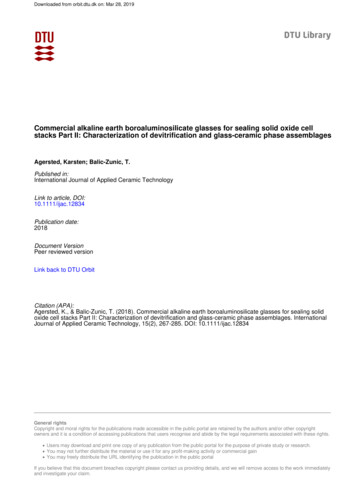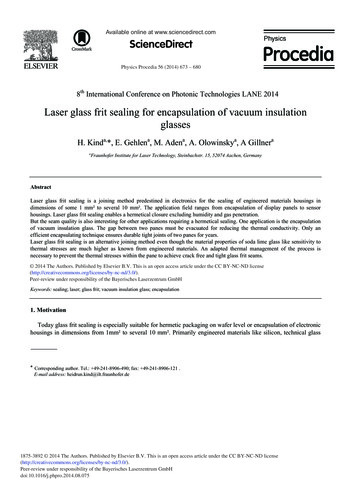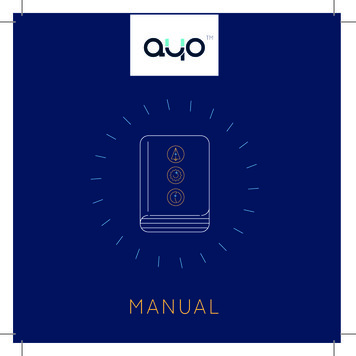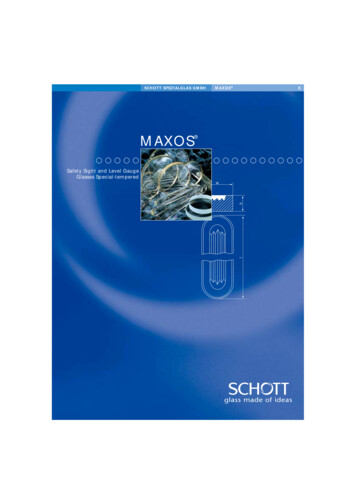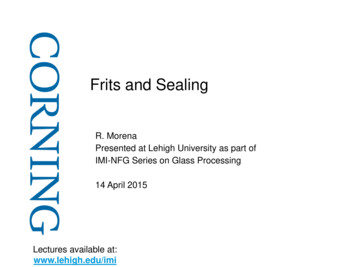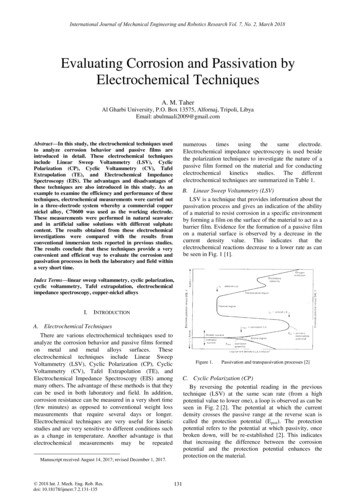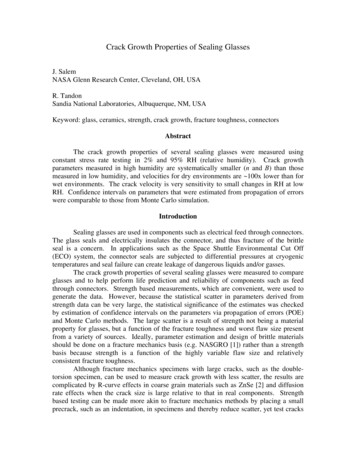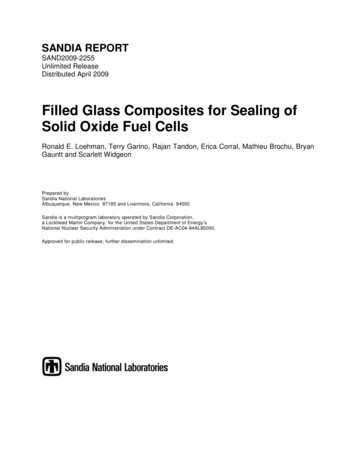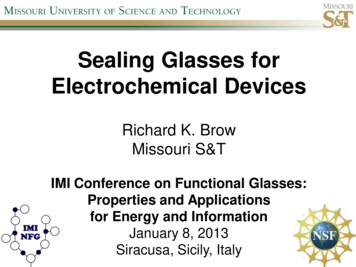
Transcription
Sealing Glasses forElectrochemical DevicesRichard K. BrowMissouri S&TIMI Conference on Functional Glasses:Properties and Applicationsfor Energy and InformationJanuary 8, 2013Siracusa, Sicily, Italy
Outline Background- and opportunities Low volume, high value technologicallyenabling glasses Ambient temperature devices Na/b-Al2O3 batteries Solid oxide fuel cells What’s next? Research focus areasIMI Conf on Functional Glasses8 January 2013RK Browbrow@mst.edu2
Function and requirements of hermetic seals Isolate components from environment Mechanically bond different components Electrically insulate one componentfrom another Weak link/strong link functionsPinGlassShell Thermo-mechanical compatibility CTE requirements (matched vs. compression) Sealing temperature Environmental stability (ambient and other component materials) Component functionality (dielectric, optical, etc. properties)IMI Conf on Functional Glasses8 January 2013RK Browbrow@mst.edu3
Why use glasses for hermetic seals? Superior hermeticity 103 lower permeation rates than polymers Compositional flexibility to tailor specific properties E.g., CTE ranges to match fused silica and copper . High temperature stability Electrically insulating Processing flexibility Viscous flow for complex shapes Solid, powder preforms; thin films Glass-ceramic options Brittle- CTE mismatches Temperature limitations Incompatible chemistriesIMI Conf on Functional Glasses8 January 2013RK Browbrow@mst.edu4
Example: High-strength seals for pyrotechnicsInconelShell High yield strengths– 100 kpsiSealingMaterial good fracture toughness excellent corrosion resistanceProblem:Hermetic seals are required toisolate air-sensitive materials.HastelloyRingsIMI Conf on Functional Glasses8 January 2013HastelloyPins Glass-ceramics are the solution good mechanical properties CTE-matches to many alloys good chemical properties convenient manufacturingRK Browbrow@mst.edu5
Conventional glass-ceramic process IMI Conf on Functional Glasses8 January 2013RK Browbrow@mst.edu6
Li-silicate glass ceramics have therequisite CTEs for super-alloy seals‘S-glass’ (mole%)23.7 Li2O 2.8 K2O 2.6 Al2O32.6 B2O3 1.0 P2O5 67.1 SiO2IMI Conf on Functional GlassesCTE depends on crystalline phases:Li-disilicate,CTE 110x10-7/ Ccristobalite,CTE 125x10-7/ C (20-100 C) 500x10-7/ C (20-300 C)RK Brow7
High temperature heterogeneous nucleationleads to desirable glass-ceramicsSeal &Nucleate Crystallize1000 C20 min820 C650 C 20 minLP15 minCRCR0.5 mm Li3PO4 nuclei form at 1000 C Epitaxial growth of cristobalite at 820 C no nuclei: low CTE Li-disilicateIMI Conf on Functional Glasses8 January 2013(Headley and Loehman, J. Am. Ceram.Soc., 1984)RK Browbrow@mst.edu8
The heterogeneous nucleation mechanism hasimportant application ramifications poorly crystallized interface Cr-phosphide crystallitesCr(metal) Li3PO4 CrxPy Li2O(gl) 25% lower CTEdetonators, actuators, boltcutters, high-voltageconnectors, etc.IMI Conf on Functional Glasses8 January 2013RK Browbrow@mst.edu9
Materials issues for designing a sealing glass CTE requirementsOther desirable physical and chemical propertiesSealing and operational temperatures Viscosity and process-required properties Long-term stability of properties Interactions with seal componentsIMI Conf on Functional Glasses8 January 2013RK Browbrow@mst.edu10
We will consider three types of electrochemical devices Lithium batteries (ambient temperatures, liquid electrolyte) Lithium stability Alkali storage batteries (intermed. temperatures, 200-400 C) Long-term alkali stability Solid oxide fuel cells (high temperatures, 600-900 C) Long-term thermo-chemical stability Failure from thermal cyclingGlass is an enabling technology to produce robust devicesIMI Conf on Functional Glasses8 January 2013RK Browbrow@mst.edu11
Glasses have been developed as electrolytesfor Li-batteriesIMI Conf on Functional Glasses8 January 2013RK Browbrow@mst.edu12
Example: Lithium D-cellMo Pin(cathode)Li anodeSeparatorS. SteelHeader(anode)CathodeCollectorLi D-cell(Li/SO2)IMI Conf on Functional Glasses8 January 2013Glass seal: electrical isolation encapsulates reactiveelectrolyteRK Browbrow@mst.edu13
Lithium and other alkalimetals react with silicateglassesLi thin film on silica at 75 C4Li SiO2 2Li2O SiMaschoff, et al., Appl. Surf. Sci. 27 (1986)IMI Conf on Functional Glasses8 January 2013RK Browbrow@mst.edu14
Silicate glass seals are attacked by lithiumConventionalsilicate sealingglass after threemonths at 70 C,Li/SOCl2electrolyteBunker et al., J.Mat. Res. 2 (1987)IMI Conf on Functional Glasses8 January 2013RK Browbrow@mst.edu15
A mechanism for glass corrosion has been establishedUnderpotential Depositionairanode(-3.2 V)glasspincorrosionfrontLi metal dep.electrolyte(Li , SO2)Reaction limits theshelf-life of Li liquidelectrolyte cells4Li SiO2 2Li2O Si(Bunker et al., J. Mater. Res., 1987.)IMI Conf on Functional Glasses8 January 2013RK Browbrow@mst.edu16
Corrosion resistant glasses have been developed70 C Li/SO2 electrolyte1. Low silica compositions– TA-23 (45 wt% SiO2) shelf-life 5 years2. Aluminoborate compositions– CABAL-12 (silica-free) 20MgO 20CaO 20Al2O3 40B2O3 shelf-life 20 years lower sealing temperature less prone to crystallizationCorrosion Rate -23 CABAL-12Applications include Li-batteries for cameras,computers, and biomedical components.IMI Conf on Functional Glasses8 January 2013RK Browbrow@mst.edu17
These glasses are used in designs for long-life Li cells
Alkaline earth aluminoborate glasses have therequisite properties for lithium battery sealsROAl2O3 Range of CTEs for varietyof pin materials Relatively low sealing temperatures( 800 C) CABAL glasses are used inNa-vapor lamps Resist attack by lithium kinetic stability (Li reduces B2O3 toboride) 20 year projected battery lifetimeB2O3How does structure affect useful properties?IMI Conf on Functional Glasses8 January 2013RK Browbrow@mst.edu19
Glass properties depend structurexRO 0.10Al2O3 (0.90-x)B2O3IMI Conf on Functional Glasses8 January 2013RK Browbrow@mst.eduBrow and Tallant, 199720
Alumina coordination also depends on )4xBaO 0.10Al2O3(0.90-x)B2O3 0.40MgO60.4RO 0.40BaO200150100500-50-100 -15020027100500-50-100 -15027Al Chem. Shift (ppm)IMI Conf on Functional Glasses8 January 2013150Al Chem. Shift (ppm)RK Browbrow@mst.eduBrow and Tallant, 199721
6.0CaOSrOBaO5.6Fraction B[4]0.35.20.24.80.14.4Average Al CN0.4Days to Corrosion by Li (150 C)The most durable glasses have tetrahedral networks0.04.00.00 0.10 0.20 0.30 0.40 0.50 0.60 0.70mole fraction ROIMI Conf on Functional Glasses8 January 5Tetrahedral Al,B/Total Al,BAqueous durability exhibitssimilar structural dependenciesRK Browbrow@mst.edu22
Spin-Off Development: Titanium Sealing Glasses Titanium alloys have a variety of useful properties– High strength-to-weight ratio– Superior corrosion resistance– Reasonable weldabilityTi5Si3(O) Potential Sealing Applications:– Satellite connectors, actuators– Implanted biomedical components(pacemakers, insulin pumps, etc.)– Biocompatible coatings on25 µmprosthetic alloysTiNSi2Limitation: Reliable, commercial hermetic sealing technology conventional silicate sealing glasses are reduced by titanium silicide formation leads to weak glass/Ti interfaces
Silicate bio-glass coatings for titanium require very short800 C/1 minute: no deleteriousprocessing timesreactions between silicate glass and Ti.900 C/1 minute: excessive interfacialreactivity between Bioglass and Ti.Pazo et al (1998)
Borate glasses are compatiblewith titanium alloysTiPinGlassSealxps304SSHeader500Silicate Glass400Borate Glass300200100Ti B2O3 TiBx TiOyIMI Conf on Functional Glasses8 January 20130Pin Pull (lbs)RK Browbrow@mst.edu25
IMI Conf on Functional Glasses8 January 2013RK Browbrow@mst.edu26
Borate glasses are now being used in a variety oftitanium biomedical applicationsPacemakers anddefibrillatorsInsulin pumpsOrthopedic pressure sensors
Bioactive borate glass coatings have been developed for titaniumHAp formationL. Peddi, RK Brow and RF Brown, J. Mater.Sci. Mater Med (2008) 19, 3145Saos-2 cell compatibilityIMI Conf on Functional Glasses8 January 2013RK Browbrow@mst.edu2828
Alkali Thermal Battery SealsIMI Conf on Functional Glasses8 January 2013RK Browbrow@mst.edu2929
Electrochemical energy storage for the green energy gridYang, et al., Chem. Rev. (2011)IMI Conf on Functional Glasses8 January 2013RK Browbrow@mst.edu30
Advanced batteries will be part of the green energy gridYang, et al., Chem. Rev. (2011)
Dunn et al., Science 334 (2011)IMI Conf on Functional Glasses8 January 2013RK Browbrow@mst.edu32
Na/NiCl2 CellGlass seal requirements a-Al2O3-to-b-Al2O3 Chemical compatibility molten, gaseous Na andhalides (electrolyte) No ‘poisoning’ ions forb-Al2O3 (sealingreactions) Operate at 300-400 C for upto 20 yearsIMI Conf on Functional Glasses8 January 2013RK Browbrow@mst.edu33
Example: Low alkali Biborosilicate glasses andglass-ceramics (Song, etal., JNCS (2011))0-62 Bi2O3replacing SiO2IMI Conf on Functional Glasses8 January 2013RK Browbrow@mst.edu34
Example: Low alkali Biborosilicate glasses andglass-ceramics (Song, etal., JNCS (2011))Wetting behavior on b-Al2O3IMI Conf on Functional Glasses8 January 2013RK Browbrow@mst.edu35
Still, there is an opportunity for new sealing materials“Major obstacles to demonstrating long-life liquid metal batteries center on the engineering of robust, high temperature, insulating seals.”- Kim et al.,Liquid Metal Batteries: Past, Present, and Future, Chemical Reviews (2013)“Chemically stable sealants” are one of the outstanding materials problemsremaining for Na/S batteries- Cheng et al. Advanced Materials (2011)IMI Conf on Functional Glasses8 January 2013RK Browbrow@mst.edu36
New designs face more complex sealing challengesPlanar Na/NiCl2 stack for load-leveling applications: same a-to-b alumina seal,but added alumina-steel sealGlass sealLu et al., High Power Planar Sodium-Nickel Chloride Battery, ECS Trans. 28(22) 7 (2010)GOMD 2010jlxx5@mail.mst.edu37
Solid Oxide Fuel CellsFrom I. Donald, et al., J Mater Sci(2011) 46:1975–2000IMI Conf on Functional Glasses8 January 2013RK Browbrow@mst.edu38
IMI Conf on Functional Glasses8 January 2013RK Browbrow@mst.edu39
Designing glasses for SOFC seals is a significant challengeFunction: Prevent mixing of fuel/oxidant within stack Prevent leaking of fuel/oxidant from stack Electrically isolate cells in stack Provide mechanical bonding of componentsChallenges: Thermal expansion matches to a variety ofmaterials Relatively high operational temperatures( 700ºC)– Long lifetimes ( 10000’s hrs)– Maintain stability over range of PO2, PH2O Relatively low sealing temperatures ( 900ºC)– Avoid altering other SOFC materialsFor some designs, glass-ceramics may be suitable, others may require viscous sealsIMI Conf on Functional Glasses8 January 2013RK Browbrow@mst.edu40
There have been anumber of recentreviews of SOFCsealing glassesJ. Mat. Sci. (2007)J. Power Sources, (2005)Mat Sci Eng B (2010)JOM, August 2006
45)BaO-(5-10.5)Al2O3-(50-57.5)SiO2. As Figure 3.10 shows; by changthe BaO/SiO2 ratio from 0.6 to 0.94, the TEC changes from 7.6- to 14.6·1 C-1. For the same glass system, the glass transformation temperaturethe softening temperature could be effectively tailored by varyingalumina content as shown in Figure 3.11.Ba-silicate glass-ceramics have shown promise161514-113-6TEC (x 10 C )Meinhardt, et al., USP 6,532,769Mar. 18, 2003121110987RO, mol%B2O3,SiO2 mol%60.500.600.700.800.901.00BaO/SiO2 (mole ratio)Figure 3.10Effect of BaO/ SiO2 ratio on the thermal expansion coefficient in a BAS glasswith composition (33.7-45)BaO-(5-10.5)Al2O3-(50-57.5)SiO2 [65]Sealed, crystallized to form highCTE Ba-silicate & Ba-aluminosilicate phases; e.g., BaO 2SiO2,2BaO 3SiO2 29Al2O3, mol%IMI Conf on Functional Glasses8 January 2013RK Browbrow@mst.edu42
Candidate sealing glasses have ‘invert’ structures“Invert Glasses”: discontinuoussilicate anions tied-together throughmodifying cations. Greater CTE’s More fragile viscosity behavior ‘shorter’ glasses More ‘basic’ reaction chemistries Metasilicates (chains): [O]/[Si] 3.0 Polysilicates (short chains): [O]/[Si] 3.0 Greater CTEs from polysilicatecrystalline phasesIMI Conf on Functional Glasses8 January 2013RK Browbrow@mst.edu43
G#50-6 oCoef. Thermal Expansion (10 / C)1412430SS10YSZ“Invert” silicate:Glasses withSiO2 45 mole%Compositions based on:Pyrosilicate andG#27Orthosilicate phases86650700750800850900oSoftening temperature ( C )IMI Conf on Functional Glasses8 January 2013RK Browbrow@mst.edu44
Pyrosilicates– CaSrAl2SiO7, Ca2ZnSi2O7Orthosilicates– Sr2SiO4, Zn2SiO4The crystalline phases appear tobe thermally stable. As-sealed(850 C/4 hrs)250020001500800CPSCaSrAl2SiO7Ca2ZnSi2O7100028 days/750 C1200400500002040608020406080
14G27G50G36-6 oCTE (10 / C)13Phase distributions canchange with time .430SSOther distributions remain stable .1211YSZ10980306090120oDays at 800 CIMI Conf on Functional Glasses8 January 2013RK Browbrow@mst.edu46
Thermo-mechanically robust seals can be made to SOFCcomponent materials750 C/two weeks in airIMI Conf on Functional Glasses8 January 2013RK Browbrow@mst.edu47
One potential problem is deleterious reactions with chromiaCTE mismatches occur atthe glass-metal interface:BaCrO4: 18 ppm/KSteel/Glass: 12ppm/KIMI Conf on Functional Glasses8 January 2013RK Browbrow@mst.edu48
G18/Crofer after 1 week at 750 C2BaO Cr2O3 ½O2 2BaCrO4Yang et al., JMEPEG 13, 327 (2004)
A second problem with ‘rigid’ glass-ceramic seals involves thethermal stresses associated with slight CTE mismatchesLiu, et al., Int. J. Appl. Cer. Tech., 8[1], 49 (2011)One solution may be to use a ‘viscous’ seal that will ‘re-heal’ on heatingIMI Conf on Functional Glasses8 January 2013RK Browbrow@mst.edu50
e, crack tip blunting alonge crack morphology are1lnðg Þ ¼ mderization of the crack nd stage, this cylindricala) and results inofRajtheglassN. Singhþ C:School of Materials Science and Engineering, Oklahoma State University, Tulsa, Oklahoma 74106-0700(Received 13 January 2012; accepted 21 May 2012)Seals are required for a functioning solid oxide fuel cell (SOFC). These seals must function athigh temperatures of 600–900 C and in oxidizing and reducing environments of the fuels and air.Among the different type of seals, the metal–ceramic seals require significant attention, research,and development because the brittle nature of ceramics and glasses leads to fracture and loss of sealintegrity and functionality. A novel concept of self-healing/self-repairable glass seals is proposed,developed, and used for making metal–glass–ceramic seals for application in SOFC for enhancingreliability and life. Glasses and glass–ceramics displaying self-healing behavior are investigated andused to fabricate seals. The performance of these seals under long-term exposure at highertemperatures coupled with thermal cycling is characterized. Self-repairability of these glass seals isalso demonstrated by leak tests along with the long-term performance. An approach for studyingthe kinetics of crack healing in glasses and glass–ceramics responsible for self-repair is brieflydescribed.ODUCTIONcracks at the SOFC operating temperatures. Therefore, theprimary focusof thispaper isastudy of thecrack-healing/selfrepair behavior of promising glasses and glass–ceramiccomposites to further advance this concept of self-repairableseals for SOFCs.oxide fuel cell (SOFC) is a solid-state energyon device that produces electricity by electrolly combining fuel and oxidant across an ionicng oxide membrane at high temperatures. 1 TheSOFC configuration is superior to other configSingh,J. Mater.2055several(2012)stagRKBrow behaviorentedcrackson Glassesa glasssurfaceand (b–f)crack-healingof Res.,aSOFCglass27[15]indicatingIMI termsConfon Functional51II. ow@mst.edu8 January 2013
We have examinedcompositions with low liquidustemperatures in the Baborosilicate systemIMI Conf on Functional Glasses8 January 2013RK Browbrow@mst.edu52
Hermetic Sealing TestsTop side0.5 psid (26 torr)YSZLowPressureNiO/YSZMeasure PViscous Glass SealFerritic SteelBottom sideHighPressureSS441Stainless SteelFurnace Glass pastes were made from powders (-45 µm) mixed with PVB binder andacetone, and used to bond NiO/YSZ bi-layer to aluminized steel (SS441)substrate (materials from PNNL) Sandwich seals fired in air at 850 C for 8 hoursIMI Conf on Functional Glasses8 January 2013RK Browbrow@mst.edu53
Viscous sealswithout failingGlass 73 Sealing Test0.5 PSI Dry Air on Metal SideSweep onNiO/YSZ SidesurveyAir 100thermalcyclesfrom 750 C9000.6100 Cycles3378 Hours8000.57000.45000.3400300Pressure (PSI)Temperature 002500.003000.0003500.00Time (Hours)IMI Conf on Functional Glasses8 January 2013RK BrowTemperature (ºC)Pressurebrow@mst.edu54
Thermally shocked sample “re-seals” when re-heatedCracked on quenchingOriginal hermetic seal ( 25 C/s)Resealed (2 hrs at 725 C)CrackSamples re-seal intwo hours withviscosities of 106 Pa-sFoaming in soapy waterIMI Conf on Functional Glasses8 January 2013RK Browbrow@mst.edu55
Reactivity CharacterizationViscous seals may beGlassmore73-cont.reactive that the glassceramicsLine ScanSS441GlassNo major Cr or Fe migration to glass sealIMI Conf on Functional Glasses8 January 2013Line ScanGlassRK Browbrow@mst.eduYSZ/NiONo elemental migration to glass seal56
temperature behavior is noted in Figure 1 for the crystallized sample held in air (dry) at 750 CFigure 1. DMA viscositydata for Glass 73 after different willthermal histories;the solid glasslines are fitsLong-termcrystallizationaffectviscosityfor 2,000hours.based on the Corning Viscosity Model.and (a)so the self-sealingproperties(b)(c)2000 hrs atTliq-50 CDMA viscosity data for Glass 73 after different thermal histories; the solid lines are fitshe Corning Viscosity Model.(b)(c)Figure 2. Scanningelectron microscopy (SEM) micrographsof Glass 73 held at 800⁰C in air for(a) 500, (b) 1,000, and (c) 2,000 hours.71000 hrs atTliq-50 CScanning electron microscopy (SEM) micrographs of Glass 73 held at 800⁰C in air for) 1,000, and (c) 2,000 hours.
Summary As a materials science platform, sealing glasses offer opportunities toexplore new compositions and to study glass phenomena Chemically stable non-silicate compositions Crystallization around the liquidus temperature High temperature compatibility with metals Glass seals are enabling materials for many technologies Reliable Li-batteries biomedical devices Optimization still required for Na/S, Na/NiCl2 and SOFC systems The ability to model sealing processes may be the key to ’scaling up’technologies to useful products Accurate viscoelastic properties Well-controlled manufacturing process parameters Well-understood ‘application’ conditions
Acknowledgments Department of Energy/SECA Mo-Sci Corp. (Rolla)- CW Kim Signo Reis, Teng Zhang, Rick Hsu National Institutes of Health Laxikanth Peddi, Heather Teitlebaum, Roger Brown Sandia National LabsIMI Conf on Functional Glasses8 January 2013RK Browbrow@mst.edu59
Grazie!GOMD 2010jlxx5@mail.mst.edu60
Sealing Glasses for Electrochemical Devices Richard K. Brow Missouri S&T IMI Conference on Functional Glasses: Properties and Applications for Energy and Information January 8, 2013 Siracusa, Sicily, Italy . Outline Background- and opportunities



